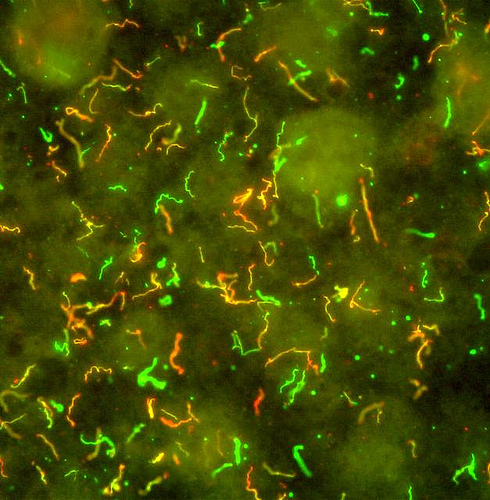Guest Post by Nancy Dougherty
 Lyme disease, first discovered over 40 years ago, is the most common vector-borne illness in the US, with over 300,000 new cases per year. Lyme disease has been reported in every state and is endemic in the Northeast, Mid-Atlantic, Upper Midwest and Northern California. NIH funding of $24M does not adequately address the growing unmet medical need or economic impact of this burgeoning worldwide pandemic. A recent study by Johns Hopkins School of Medicine indicates the medical cost of Lyme disease in the US presently exceeds $1.3 billion, and that does not reflect the additional financial impact of lost employment, schooling or productivity, and out of pocket health expenditures that often run in the tens of thousands.
Lyme disease, first discovered over 40 years ago, is the most common vector-borne illness in the US, with over 300,000 new cases per year. Lyme disease has been reported in every state and is endemic in the Northeast, Mid-Atlantic, Upper Midwest and Northern California. NIH funding of $24M does not adequately address the growing unmet medical need or economic impact of this burgeoning worldwide pandemic. A recent study by Johns Hopkins School of Medicine indicates the medical cost of Lyme disease in the US presently exceeds $1.3 billion, and that does not reflect the additional financial impact of lost employment, schooling or productivity, and out of pocket health expenditures that often run in the tens of thousands.
People with early Lyme disease infection from a tick bite typically present with symptoms of summer flu (fever, body aches, headaches) but not everyone exhibits a recognizable erythema migrans or bulls-eye rash. Diagnostic antibody tests are unreliable, and thus, many cases are missed or misdiagnosed. Disseminated Lyme disease can substantially impact the quality of life by causing extreme fatigue, arthritis, severe neuromuscular and neurologic inflammation and pain, cognitive dysfunction, and life-threatening carditis. Early diagnosed and treated patients have the best outcomes, but of those treated early with antibiotics, 10-20% experience persistent symptoms of Post-Treatment Lyme Disease Syndrome (PTLDS) that can be multi-systemic and debilitating. The emotional and physical pain can sometimes lead to suicide, another tragic outcome of Lyme disease.
Lyme disease is heterogeneous and can be caused by numerous strains and genotypes of bacteria, including Borrelia burgdorferi, Borrelia miyomotoi , Borrelia mayonii , Borrelia lonestari in the States and B. burgdorferi, B. afzelii and B. garinii in Eurasia. Co-pathogens can further complicate diagnosis and treatment and include babesia, bartonella, ehrlichia, mycoplasma, rocky mountain spotted fever, anaplasma, & Powassan virus. Current diagnostic tests do not adequately cover the full array of pathogens.
The complex molecular disease mechanisms of Lyme disease are not well understood. At the February 2016, American Association for the Advancement of Science (AAAS) in Washington D.C. Lyme disease was featured as a lead example of an illness poised to benefit from precision medicine and the big data revolution. The SLICE study led by John Aucott, MD, at the Lyme Disease Clinical Research Center at Johns Hopkins Division of Rheumatology is utilizing big data and “omics” tools to better understand the roles of bacterial persistence, immune dysfunction and pathological inflammation in human Lyme disease mechanisms. Cytokine, metabolic and transcriptome biosignatures are being investigated in collaboration with other leading academic universities. A recent transcriptome analysis published by a Hopkins-UCSF collaboration identified a unique Lyme disease gene expression signature that can potentially be used as a biomarker for improving diagnostics and disease management.
Renowned Duke University oncologist Neil Spector, MD, (author of “Gone in A Heartbeat “) advocates for a personalized medicine approach for Lyme disease, such as he helped pioneer for breast cancer. Dr. Spector’s Lyme disease was misdiagnosed for many years and necessitated a pacemaker, defibrillator and ultimately a life-saving heart transplant. Dr. Spector’s case highlights the urgent need for improved care for Lyme disease patients.
Understanding the genetic makeup of patient and pathogen(s) should help determine more optimal courses of treatment. The stealth tissue-homing Lyme bacteria has evolved to evade our immune system and take advantage of human host genetic vulnerabilities to potentially trigger autoimmune, neurologic or cardiac illness. More research is needed to better understand the roles of persisters, morphologic variants and efflux transporters in Lyme infection biology. Understanding similar mechanisms and heterogeneity in breast cancer has helped create a more effective precision medicine approach for patients. Improved outcomes have also occurred with targeted combination therapies for complex infections such as HIV/AIDS and Hep C. Likewise, a more comprehensive and personalized diagnostic and treatment approach to Lyme disease needs to be developed.
To harness precision medicine, big data innovation and collaboration, the first Lyme disease hackathon, “Lyme Innovation”, will take place during three events this spring. This effort is being led by the Dean Center for Tick Borne Illness at Spaulding Rehabilitation Network/Harvard Medical School Department of Physical Medicine and Rehabilitation and is sponsored by the Bay Area Lyme Foundation. Synergistic mini-hackathon events at MIT and UC Berkeley, on April 16, are designed to educate and energize teams on both coasts to solve critical prevention, diagnostic, and treatment challenges facing Lyme disease. These will lead to a full three-day hackathon on June 17-19 at the Microsoft Nerd Center in Cambridge, MA. Prizes will be awarded at all events to top teams as judged by a panel of innovation, business, and Lyme disease experts. The MassBio community is encouraged to participate. To learn more and register, please visit www.lymeinnovation.org.
Photo: “Lyme Disease Bacteria, Borrelia burgdorferi” by NIAID_Flickr is licensed under CC BY 2.5
About the Author:
 Nancy Dougherty serves as an Advisory Board Member of the Dean Center for Tick Borne Illness at Spaulding Rehabilitation Hospital in Charlestown, MA. Nancy is Principal of NVantage Consulting, LLC, Boston, MA, and provides strategic fundraising and communications support to the life sciences industry. Previous positions include Leadership Gifts Development Officer for the Lyme Disease Research Foundation, Baltimore, MD, and Vice President-Investments, Biotechnology & Pharmaceutical Equity Analyst, for MFS, Boston, MA.
Nancy Dougherty serves as an Advisory Board Member of the Dean Center for Tick Borne Illness at Spaulding Rehabilitation Hospital in Charlestown, MA. Nancy is Principal of NVantage Consulting, LLC, Boston, MA, and provides strategic fundraising and communications support to the life sciences industry. Previous positions include Leadership Gifts Development Officer for the Lyme Disease Research Foundation, Baltimore, MD, and Vice President-Investments, Biotechnology & Pharmaceutical Equity Analyst, for MFS, Boston, MA.
Guest postings on the MassBio blog in no way represent the opinions or endorsement of MassBio or its officers, directors, employees, agents, and consultants. MassBio does not represent or guarantee the truthfulness, accuracy, or reliability of statements or facts posted under the Guest postings on the MassBio blog. MassBio accepts no liability for errors, omissions or representations. The copyright of guest content belongs to the author and any liability with regard to infringement or intellectual property remains with the author.